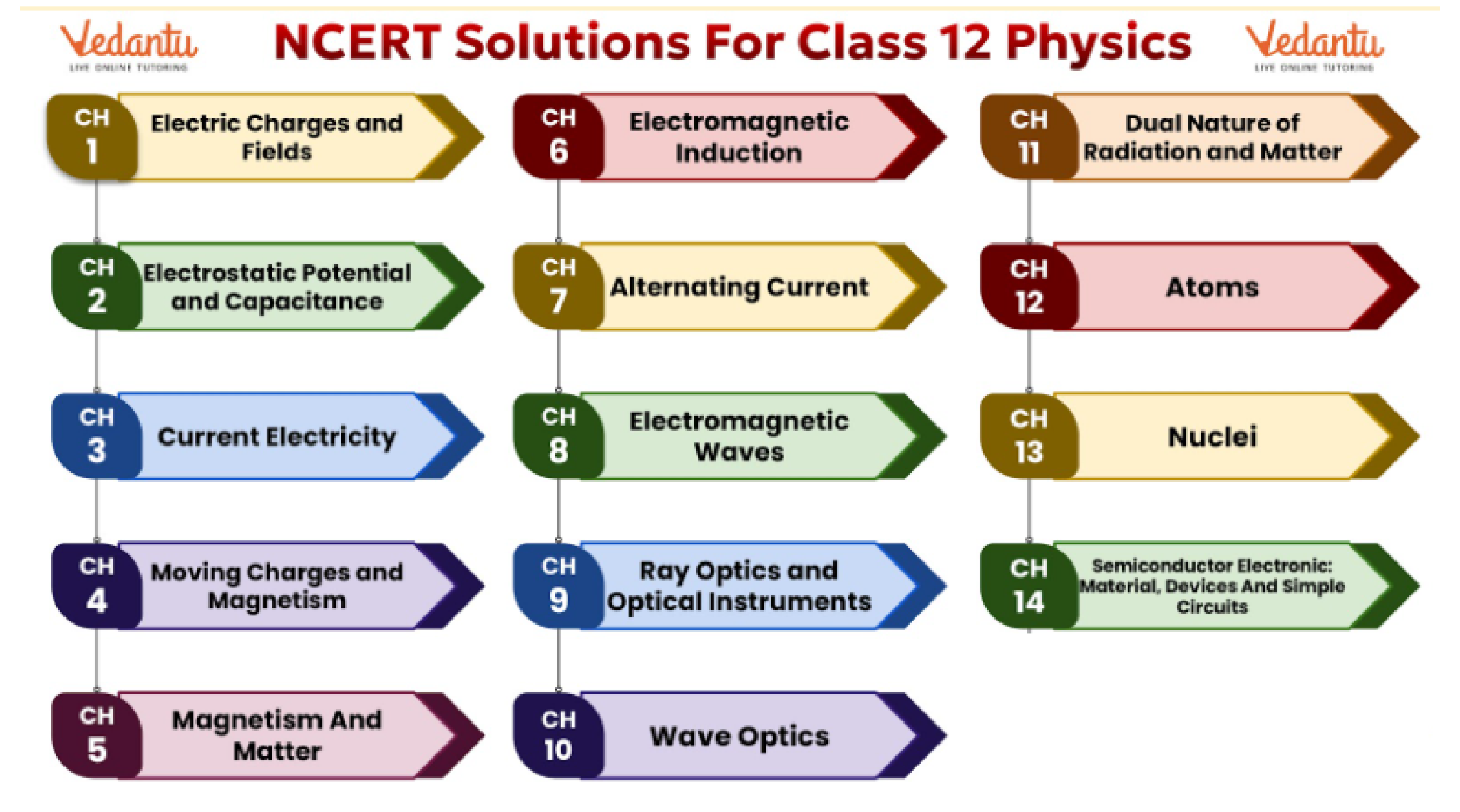Chapter-wise Class 12 Physics Questions and Answers Free PDF Download
FAQs on NCERT Solutions For Class 12 Physics All Chapters - 2025-26
1. Are these NCERT Solutions for Class 12 Physics updated for the 2025-26 CBSE syllabus?
Yes, these NCERT Solutions are fully updated to align with the latest CBSE syllabus for the 2025-26 academic year. All solutions for the 14 prescribed chapters are provided as per the revised and rationalised curriculum, ensuring you study only the relevant topics for your exams.
2. How many chapters are covered in the Class 12 Physics NCERT Solutions?
The NCERT Solutions cover all 14 chapters present in the revised Class 12 Physics textbook for the 2025-26 session. The chapters are:
- Electric Charges and Fields
- Electrostatic Potential and Capacitance
- Current Electricity
- Moving Charges and Magnetism
- Magnetism and Matter
- Electromagnetic Induction
- Alternating Current
- Electromagnetic Waves
- Ray Optics and Optical Instruments
- Wave Optics
- Dual Nature of Radiation and Matter
- Atoms
- Nuclei
- Semiconductor Electronics: Materials, Devices and Simple Circuits
3. How do NCERT Solutions help in tackling difficult chapters in Class 12 Physics?
Many students find chapters like Wave Optics or Electromagnetic Induction challenging. The NCERT Solutions help by providing:
- Step-by-step breakdowns of complex derivations and numerical problems.
- Clear explanations of the underlying principles for each question.
- Diagrams and illustrations to help visualise difficult concepts, making them easier to understand and retain.
4. Why is it important to follow the step-by-step method provided in the NCERT Solutions?
Following the step-by-step method is crucial for board exams. The CBSE values a systematic approach to problem-solving. These solutions demonstrate the correct methodology to:
- Clearly state the given data and the formula used.
- Show all intermediate calculation steps logically.
- Arrive at the final answer with the correct units.
This practice helps secure full marks for a question, even if the final calculation has a minor error.
5. How do the NCERT Solutions for Class 12 Physics cater to both theoretical and numerical questions?
The solutions are designed to address all question types in the NCERT textbook. For theoretical questions, they provide precise, point-wise answers as expected by the CBSE. For numerical problems, they offer a detailed, step-by-step guide from identifying the formula to the final calculation, ensuring a complete understanding of the application of concepts.
6. Can I score full marks in the CBSE board exam by only using these NCERT Solutions?
The NCERT textbook and its solutions are the foundation for the CBSE board exam. Mastering them is the most critical step toward scoring high marks. These solutions ensure you have a thorough understanding of every concept and problem in the textbook. For achieving a perfect score, it is recommended to supplement this with practice from sample papers and previous years' question papers to improve speed and familiarity with the exam pattern.
7. Beyond solving textbook exercises, how can Class 12 Physics NCERT Solutions improve my problem-solving skills for competitive exams?
While these solutions are tailored for the CBSE pattern, they build a strong conceptual foundation essential for competitive exams. By understanding the first-principles approach used to solve NCERT problems, you develop the analytical thinking required for exams like NEET and JEE. They clarify core concepts like electromagnetism and modern physics, which are high-weightage topics in entrance exams.
8. Which chapter's NCERT solutions are considered the longest or most detailed?
Chapters like Ray Optics and Optical Instruments and Electrostatic Potential and Capacitance often have the most extensive sets of exercises. Their NCERT solutions are consequently more detailed, covering a wide range of derivations, conceptual questions, and complex numerical problems that require a deep understanding of multiple concepts.
9. Do the NCERT Solutions cover the types of questions that are frequently repeated in CBSE Class 12 Physics board exams?
Yes. The CBSE board exam heavily relies on the concepts and question patterns found in the NCERT textbook. By thoroughly working through these solutions, you are effectively preparing for a majority of the questions that appear in the exam, as many are either directly from the textbook or based on the same principles and derivations.
10. Is it better to read the chapter first or directly jump to the NCERT Solutions for difficult questions?
It is always more effective to read the chapter thoroughly first. Attempt to solve the exercise questions on your own. Use the NCERT Solutions as a tool for verification and to understand the correct approach for questions you found difficult or couldn't solve. Directly jumping to solutions can hinder the development of your own problem-solving abilities.
11. How do the solutions for 'Moving Charges and Magnetism' connect with 'Electromagnetic Induction'?
The NCERT solutions help bridge the conceptual gap between these two related chapters. The solutions in 'Moving Charges and Magnetism' establish the principle that moving charges create magnetic fields. The solutions in 'Electromagnetic Induction' then demonstrate the inverse relationship: a changing magnetic field induces an electric current. By working through both, you can see the fundamental symmetry and interconnectedness of electricity and magnetism as presented in the syllabus.


























